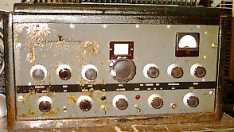
Basic Information:
The Johnson Viking I transmitter was made from 1949 to 1952, and was sold as a kit for $209.50 or assembled for $259.50. It is crystal-controlled and covers the 160-10M amateur bands. The tube lineup is a 6AU6 oscillator, 6AQ5 buffer/doubler, 4D32 final amp, 6AU6 microphone amp, 6AU6 driver, and push-pull 807's in the modulator. Power input to the final is 115W CW and 100W AM, although some examples use an 829B as the final with inputs of 100W CW and 85W AM. The final amplifier is tuned continuously by a pi-network using a rotary inductor ganged to a variable capacitor, and the oscillator and driver are bandswitched.
Frequency Ranges:
In addition to the usual U.S. amateur radio bands, the unit will cover the following ranges of transmitting frequencies.

This table was determined experimentally using a vfo input to the external crystal connection.
Modifications:
The audio quality is excellent for speech, but can be improved substantially be adding negative feedback directly from the modulated B+ source back to the preamp. After this modification, and operating the unit at about 10 watts carrier output, so that the somewhat small modulation transformer can also operate at a low power level, the frequency response can be made fairly flat from 200Hz to 6KHz, and distortion is greatly reduced. At this point, it would be up to the user to pre-filter the audio signal to limit the high frequencies to 3KHz, to conform to the conventions of amateur radio AM operating practice.

